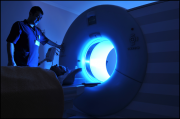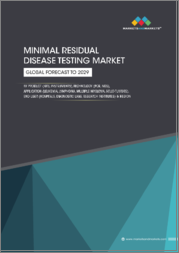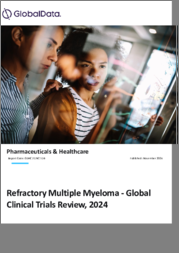
|
시장보고서
상품코드
1540996
세계의 다발성골수종 치료제 시장 보고서 : 치료법, 약물 유형, 최종사용자, 유통채널, 지역별(2024-2032년)Multiple Myeloma Drugs Market Report by Therapy, Drug Type, End-User, Distribution Channel, and Region 2024-2032 |
||||||
세계 다발성 골수종 치료 시장 규모는 2023년 223억 달러에 달했습니다. 향후 IMARC Group은 2024-2032년 연평균 성장률(CAGR) 5.2%로 2032년에는 355억 달러에 달할 것으로 예상하고 있습니다.
다발성 골수종은 주로 형질세포를 침범하는 혈액암의 일종입니다. 가장 일반적인 다발성 골수종 치료에는 화학요법제, 코르티코스테로이드, 면역조절제 등이 있습니다. 이러한 의약품은 뼈의 치유를 촉진하고 고칼슘혈증, 골절, 척수 압박, 빈혈을 예방하는 동시에 화학요법의 필요성을 최소화합니다. 화학요법제에는 각종 안트라사이클린계 항생제와 멜파란, 독소루비신, 빈크리스틴, 리포좀 독소루비신과 같은 알킬화제가 포함됩니다. 표적 치료에는 보르테조밉과 같은 프로테아좀 억제제, 덱사메타손, 프레드니손, 살리도마이드와 같은 다양한 화합물이 포함됩니다.
혈액암의 유병률 증가와 함께 의료 부문의 큰 발전은 시장 성장을 가속하는 주요 요인 중 하나입니다. 다발성 골수종은 일반적으로 특정 유전자 이상으로 인해 발생하며, 이 질환의 치료에는 면역 체계를 조절하고 화학 요법, 방사선 요법, 줄기 세포 이식, 혈소판 수혈의 효율성을 높이는 데 도움이 되는 약물이 포함됩니다. 또한, 골수종 세포를 식별하고 공격하기 위해 신체의 면역 체계를 활용하는 생물학적 제제의 이점에 대한 소비자의 인식이 높아지면서 시장 성장을 가속하고 있습니다. 또한, 다발성 골수종 치료를 위한 마이크로 RNA 치료 및 나노 의약품 개발 등 다양한 기술 발전이 또 다른 성장 촉진요인으로 작용하고 있습니다. 이러한 의약품은 골수에 고분자 약물의 전달을 촉진하고 항종양 반응을 촉매하는 데 사용됩니다. 기타 요인으로는 의료비 증가와 의료 과학 부문의 광범위한 조사 및 개발 활동이 시장을 더욱 견인할 것으로 예상됩니다.
본 보고서에서 다룬 주요 질문들
- 세계 다발성 골수종 치료제 시장은 지금까지 어떻게 성장해왔고, 앞으로 어떻게 발전할 것인가?
- 주요 지역 시장은?
- 코로나19는 세계 다발성 골수종 치료제 시장에 어떤 영향을 미쳤을까?
- 치료법별 시장 현황은?
- 약제 유형별 시장 현황은?
- 최종사용자별 시장 분석은?
- 유통채널별 시장 현황은?
- 산업 가치사슬의 다양한 단계는?
- 업계의 주요 촉진요인과 과제는?
- 세계 다발성 골수종 치료제 시장 구조와 주요 진출 기업은?
- 업계의 경쟁은 어느 정도인가?
목차
제1장 서문
제2장 조사 범위와 조사 방법
- 조사 목적
- 이해관계자
- 데이터 소스
- 1차 정보
- 2차 정보
- 시장 추정
- 보텀업 접근
- 톱다운 접근
- 조사 방법
제3장 주요 요약
제4장 서론
- 개요
- 주요 업계 동향
제5장 파이프라인 평가/임상시험 제품/임상 개발
- PegIntron (Pegylated interferon alfa-2b)
- Pomalidomide
- Tanespimycin (KOS-953)
- MLN 9708
- SRT-501- 012
- BHQ880
- Panobinostat
- ZIO-101
- VEGF-Trap(Aflibercept)
- Denosumab
- Perifosine
- Actimid (CC-5013)
- Romidepsin
- Plitidepsin (Aplidin)
- Temsirolimus (Torisel)
- Sorafenib
- Bevacizumab
제6장 세계의 다발성 골수종 치료 시장
- 시장 개요
- 시장 실적
- COVID-19의 영향
- 시장 예측
제7장 시장 분석 : 치료법별
- 표적치료
- 생물학적 요법
- 화학요법
- 기타
제8장 시장 분석 : 약제 유형별
- 면역 조절제
- 프로테아좀 억제제
- 히스톤 탈아세틸화 효소 억제제
- 단클론항체 의약품
- 스테로이드
- 기타
제9장 시장 분석 : 최종사용자별
- 남성
- 여성
제10장 시장 분석 : 유통 채널별
- 병원 약국
- 소매 약국
- 온라인 약국
- 기타
제11장 시장 분석 : 지역별
- 북미
- 미국
- 캐나다
- 아시아태평양
- 중국
- 일본
- 인도
- 한국
- 호주
- 인도네시아
- 기타
- 유럽
- 독일
- 프랑스
- 영국
- 이탈리아
- 스페인
- 러시아
- 기타
- 라틴아메리카
- 브라질
- 멕시코
- 기타
- 중동 및 아프리카
- 시장 동향
- 시장 분석 : 국가별
- 시장 예측
제12장 SWOT 분석
- 개요
- 강점
- 약점
- 기회
- 위협
제13장 밸류체인 분석
제14장 Porter의 Five Forces 분석
- 개요
- 바이어의 교섭력
- 공급 기업의 교섭력
- 경쟁 정도
- 신규 진출업체의 위협
- 대체품의 위협
제15장 가격 지표
제16장 경쟁 구도
- 시장 구조
- 주요 기업
- 주요 기업 개요
- Amgen Inc.
- Bristol Myers Squibb
- Daiichi Sankyo Co.
- Sanofi-Aventis Groupe(Genzyme Corporation)
- Johnson & Johnson Services, Inc.
- Merck & Co., Inc.
- Novartis International AG
- Pfizer Inc.
- PHARMA MAR, S.A.
- Takeda Pharmaceutical Company Limited.
- Teva Pharmaceutical Industries Ltd.
The global multiple myeloma drugs market size reached US$ 22.3 Billion in 2023. Looking forward, IMARC Group expects the market to reach US$ 35.5 Billion by 2032, exhibiting a growth rate (CAGR) of 5.2% during 2024-2032.
Multiple myeloma, or Kahler's disease, refers to a form of blood cancer that primarily affects the plasma cells. Some of the most common types of multiple myeloma drugs include chemotherapeutic agents, corticosteroids and immunomodulatory agents. These pharmaceutical drugs aid in promoting bone healing, prevent hypercalcemia, bone fracture, spinal cord compression and anemia, while minimizing the need for chemotherapy. The chemotherapeutic agents include various anthracycline antibiotics and alkylating agents, such as melphalan, doxorubicin, vincristine and liposomal doxorubicin. The targeted therapy drugs include proteasome inhibitor, such as bortezomib, and various other compounds, including dexamethasone, prednisone and thalidomide.
Significant developments in the healthcare sector, along with the increasing prevalence of hematological cancer, is one of the key factors driving the growth of the market. Multiple myeloma is usually caused by specific genetic abnormalities, and the treatment of this disease involves drugs that modulate the immune system and aid in enhancing the efficiency of chemotherapies, radiation therapies, stem cell transplants and platelet transfusion. Furthermore, rising consumer awareness regarding the benefits of biologic therapy drugs, which utilize the body's immune system to identify and attack the myeloma cells, is also providing a boost to the market growth. Additionally, various technological advancements, such as the development of microRNA therapeutics and nanomedicines for the treatment of multiple myeloma, is acting as another growth-inducing factor. These medicines are used to facilitate the delivery of macromolecular agents into the bone marrow and catalyze antitumor responses. Other factors, including the rising healthcare expenditures and extensive research and development (R&D) activities in the field of medical sciences, are projected to drive the market further.
Key Market Segmentation:
IMARC Group provides an analysis of the key trends in each sub-segment of the global multiple myeloma drugs market report, along with forecasts at the global, regional and country level from 2024-2032. Our report has categorized the market based on therapy, drug type, end-user and distribution channel.
Breakup by Therapy:
Targeted Therapy
Biologic Therapy
Chemotherapy
Others
Breakup by Drug Type:
Immunomodulatory Drugs
Proteasome Inhibitors
Histone Deacetylase Inhibitors
Monoclonal Antibody Drugs
Steroids
Others
Breakup by End-User:
Men
Women
Breakup by Distribution Channel:
Hospital Pharmacies
Retail Pharmacies
Online Pharmacies
Others
Breakup by Region:
North America
United States
Canada
Asia Pacific
China
Japan
India
South Korea
Australia
Indonesia
Others
Europe
Germany
France
United Kingdom
Italy
Spain
Russia
Others
Latin America
Brazil
Mexico
Others
Middle East and Africa
Competitive Landscape:
The report has also analysed the competitive landscape of the market with some of the key players being Amgen Inc., Bristol Myers Squibb, Daiichi Sankyo Co., Ltd., Sanofi-Aventis Groupe (Genzyme Corporation), Johnson & Johnson Services, Inc., Merck & Co., Inc., Novartis International AG, Pfizer Inc., PHARMA MAR, S.A., Takeda Pharmaceutical Company Limited, Teva Pharmaceutical Industries Ltd., etc.
Key Questions Answered in This Report:
- How has the global multiple myeloma drugs market performed so far and how will it perform in the coming years?
- What are the key regional markets?
- What has been the impact of COVID-19 on the global multiple myeloma drugs market?
- What is the breakup of the market based on the therapy?
- What is the breakup of the market based on the drug type?
- What is the breakup of the market based on the end-user?
- What is the breakup of the market based on the distribution channel?
- What are the various stages in the value chain of the industry?
- What are the key driving factors and challenges in the industry?
- What is the structure of the global multiple myeloma drugs market and who are the key players?
- What is the degree of competition in the industry?
Table of Contents
1 Preface
2 Scope and Methodology
- 2.1 Objectives of the Study
- 2.2 Stakeholders
- 2.3 Data Sources
- 2.3.1 Primary Sources
- 2.3.2 Secondary Sources
- 2.4 Market Estimation
- 2.4.1 Bottom-Up Approach
- 2.4.2 Top-Down Approach
- 2.5 Forecasting Methodology
3 Executive Summary
4 Introduction
- 4.1 Overview
- 4.2 Key Industry Trends
5 Pipeline Assesment/Clinical Trial Products/Clinical Developments
- 5.1 PegIntron (Pegylated interferon alfa-2b)
- 5.2 Pomalidomide
- 5.3 Tanespimycin (KOS-953)
- 5.4 MLN 9708
- 5.5 SRT-501- 012
- 5.6 BHQ880
- 5.7 Panobinostat
- 5.8 ZIO-101
- 5.9 VEGF-Trap(Aflibercept)
- 5.10 Denosumab
- 5.11 Perifosine
- 5.12 Actimid (CC-5013)
- 5.13 Romidepsin
- 5.14 Plitidepsin (Aplidin)
- 5.15 Temsirolimus (Torisel)
- 5.16 Sorafenib
- 5.17 Bevacizumab
6 Global Multiple Myeloma Drugs Market
- 6.1 Market Overview
- 6.2 Market Performance
- 6.3 Impact of COVID-19
- 6.4 Market Forecast
7 Market Breakup by Therapy
- 7.1 Targeted Therapy
- 7.1.1 Market Trends
- 7.1.2 Market Forecast
- 7.2 Biologic Therapy
- 7.2.1 Market Trends
- 7.2.2 Market Forecast
- 7.3 Chemotherapy
- 7.3.1 Market Trends
- 7.3.2 Market Forecast
- 7.4 Others
- 7.4.1 Market Trends
- 7.4.2 Market Forecast
8 Market Breakup by Drug Type
- 8.1 Immunomodulatory Drugs
- 8.1.1 Market Trends
- 8.1.2 Market Forecast
- 8.2 Proteasome Inhibitors
- 8.2.1 Market Trends
- 8.2.2 Market Forecast
- 8.3 Histone Deacetylase Inhibitors
- 8.3.1 Market Trends
- 8.3.2 Market Forecast
- 8.4 Monoclonal Antibody Drugs
- 8.4.1 Market Trends
- 8.4.2 Market Forecast
- 8.5 Steroids
- 8.5.1 Market Trends
- 8.5.2 Market Forecast
- 8.6 Others
- 8.6.1 Market Trends
- 8.6.2 Market Forecast
9 Market Breakup by End-User
- 9.1 Men
- 9.1.1 Market Trends
- 9.1.2 Market Forecast
- 9.2 Women
- 9.2.1 Market Trends
- 9.2.2 Market Forecast
10 Market Breakup by Distribution Channel
- 10.1 Hospital Pharmacies
- 10.1.1 Market Trends
- 10.1.2 Market Forecast
- 10.2 Retail Pharmacies
- 10.2.1 Market Trends
- 10.2.2 Market Forecast
- 10.3 Online Pharmacies
- 10.3.1 Market Trends
- 10.3.2 Market Forecast
- 10.4 Others
- 10.4.1 Market Trends
- 10.4.2 Market Forecast
11 Market Breakup by Region
- 11.1 North America
- 11.1.1 United States
- 11.1.1.1 Market Trends
- 11.1.1.2 Market Forecast
- 11.1.2 Canada
- 11.1.2.1 Market Trends
- 11.1.2.2 Market Forecast
- 11.1.1 United States
- 11.2 Asia Pacific
- 11.2.1 China
- 11.2.1.1 Market Trends
- 11.2.1.2 Market Forecast
- 11.2.2 Japan
- 11.2.2.1 Market Trends
- 11.2.2.2 Market Forecast
- 11.2.3 India
- 11.2.3.1 Market Trends
- 11.2.3.2 Market Forecast
- 11.2.4 South Korea
- 11.2.4.1 Market Trends
- 11.2.4.2 Market Forecast
- 11.2.5 Australia
- 11.2.5.1 Market Trends
- 11.2.5.2 Market Forecast
- 11.2.6 Indonesia
- 11.2.6.1 Market Trends
- 11.2.6.2 Market Forecast
- 11.2.7 Others
- 11.2.7.1 Market Trends
- 11.2.7.2 Market Forecast
- 11.2.1 China
- 11.3 Europe
- 11.3.1 Germany
- 11.3.1.1 Market Trends
- 11.3.1.2 Market Forecast
- 11.3.2 France
- 11.3.2.1 Market Trends
- 11.3.2.2 Market Forecast
- 11.3.3 United Kingdom
- 11.3.3.1 Market Trends
- 11.3.3.2 Market Forecast
- 11.3.4 Italy
- 11.3.4.1 Market Trends
- 11.3.4.2 Market Forecast
- 11.3.5 Spain
- 11.3.5.1 Market Trends
- 11.3.5.2 Market Forecast
- 11.3.6 Russia
- 11.3.6.1 Market Trends
- 11.3.6.2 Market Forecast
- 11.3.7 Others
- 11.3.7.1 Market Trends
- 11.3.7.2 Market Forecast
- 11.3.1 Germany
- 11.4 Latin America
- 11.4.1 Brazil
- 11.4.1.1 Market Trends
- 11.4.1.2 Market Forecast
- 11.4.2 Mexico
- 11.4.2.1 Market Trends
- 11.4.2.2 Market Forecast
- 11.4.3 Others
- 11.4.3.1 Market Trends
- 11.4.3.2 Market Forecast
- 11.4.1 Brazil
- 11.5 Middle East and Africa
- 11.5.1 Market Trends
- 11.5.2 Market Breakup by Country
- 11.5.3 Market Forecast
12 SWOT Analysis
- 12.1 Overview
- 12.2 Strengths
- 12.3 Weaknesses
- 12.4 Opportunities
- 12.5 Threats
13 Value Chain Analysis
14 Porters Five Forces Analysis
- 14.1 Overview
- 14.2 Bargaining Power of Buyers
- 14.3 Bargaining Power of Suppliers
- 14.4 Degree of Competition
- 14.5 Threat of New Entrants
- 14.6 Threat of Substitutes
15 Price Indicators
16 Competitive Landscape
- 16.1 Market Structure
- 16.2 Key Players
- 16.3 Profiles of Key Players
- 16.3.1 Amgen Inc.
- 16.3.1.1 Company Overview
- 16.3.1.2 Product Portfolio
- 16.3.1.3 Financials
- 16.3.1.4 SWOT Analysis
- 16.3.2 Bristol Myers Squibb
- 16.3.2.1 Company Overview
- 16.3.2.2 Product Portfolio
- 16.3.2.3 Financials
- 16.3.2.4 SWOT Analysis
- 16.3.3 Daiichi Sankyo Co.
- 16.3.3.1 Company Overview
- 16.3.3.2 Product Portfolio
- 16.3.3.3 Financials
- 16.3.3.4 SWOT Analysis
- 16.3.4 Sanofi-Aventis Groupe (Genzyme Corporation)
- 16.3.4.1 Company Overview
- 16.3.4.2 Product Portfolio
- 16.3.4.3 SWOT Analysis
- 16.3.5 Johnson & Johnson Services, Inc.
- 16.3.5.1 Company Overview
- 16.3.5.2 Product Portfolio
- 16.3.5.3 Financials
- 16.3.5.4 SWOT Analysis
- 16.3.6 Merck & Co., Inc.
- 16.3.6.1 Company Overview
- 16.3.6.2 Product Portfolio
- 16.3.6.3 Financials
- 16.3.6.4 SWOT Analysis
- 16.3.7 Novartis International AG
- 16.3.7.1 Company Overview
- 16.3.7.2 Product Portfolio
- 16.3.7.3 Financials
- 16.3.7.4 SWOT Analysis
- 16.3.8 Pfizer Inc.
- 16.3.8.1 Company Overview
- 16.3.8.2 Product Portfolio
- 16.3.8.3 Financials
- 16.3.8.4 SWOT Analysis
- 16.3.9 PHARMA MAR, S.A.
- 16.3.9.1 Company Overview
- 16.3.9.2 Product Portfolio
- 16.3.9.3 Financials
- 16.3.10 Takeda Pharmaceutical Company Limited.
- 16.3.10.1 Company Overview
- 16.3.10.2 Product Portfolio
- 16.3.10.3 Financials
- 16.3.10.4 SWOT Analysis
- 16.3.11 Teva Pharmaceutical Industries Ltd.
- 16.3.11.1 Company Overview
- 16.3.11.2 Product Portfolio
- 16.3.11.3 Financials
- 16.3.11.4 SWOT Analysis
- 16.3.1 Amgen Inc.



















